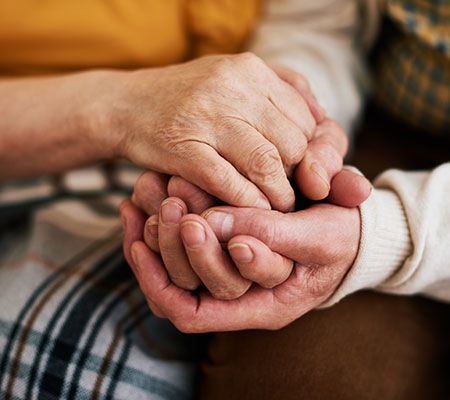Writing a sentence, eating a spoonful of soup or buttoning a shirt may seem like simple tasks. However, if you have tremors in your hand, head, voice, legs or trunk causing shaking, these tasks can be daunting. Occupational therapy can help.

Fifty percent of tremors are hereditary, although no specific gene has been identified.
Essential tremor
Essential tremor, or ET, is the most common movement disorder among adults. According to the International Essential Tremor Foundation, ET is a neurological condition that causes a rhythmic trembling or shaking of the hands, head, voice, legs or trunk.
“It is often confused with Parkinson’s disease although essential tremor is eight times more common, affecting an estimated 7 to 10 million Americans and millions more worldwide,” said Anna Rinholen, occupational therapist at Marshfield Clinic Health System.
RELATED ARTICLE: Treating Parkinson’s symptoms improves quality of life
Functional tremor
Just like ET, functional tremor, or FT, causes involuntary (uncontrollable) rhythmic movements, usually of an arm or leg. FT can occur when the nervous system is not working properly.
“Just as with ET and Parkinson’s tremors, people with FT experience emotional distress and often some degree of disability,” Rinholen said. “However, no underlying physical cause can be found.”
Occupational therapy
A thorough neurological examination with a health care provider will help to assess the tremor to determine the cause. Though there are differences in ET and FT, if one has a tremor, an occupational therapist can be requested and then review how the tremor is impacting your day-to-day life. This tremor can be addressed whether newly diagnosed or present for some time. The occupational therapist can do a comprehensive evaluation to help establish a personalized program.
“Occupational therapy can look at areas of eating, dressing, bathing, toileting, grooming, driving, cooking, home management, handwriting, and many more daily activities at home and in the community,” Rinholen said. “The purpose of occupational therapy is to teach modifications, adaptations and strategies to that make functioning for individuals easier in each and/or all of those areas.”
Occupational therapy can address, but is not limited to, the following:
- Proper body mechanics and stability for hand control
- Adaptive devices, such as weighted utensils
- Modification of a task
- Technology options, such as kitchen tools
- Handwriting concerns
- Coping tips for stress reduction
- Any related fatigue or pain
- Exercise programs
DBS therapy and other treatments
In addition to occupational therapy, your neurology team can further address other common therapy, such as medication or surgical interventions like DBS therapy. During DBS therapy, a small, pacemaker-like device is placed under the skin in the chest. This device sends electronic signals to an area in the brain that controls movement and these signals block some brain messages that cause disabling motor symptoms. Very thin wires connect it to the brain to enable signals to reach the source of tremor symptoms.
Collaboration with the neurologist and occupational therapist can assist in management and reduction of the symptoms, including appropriate tips.
“There are ways to minimize the effects of tremors on your daily life,” Rinholen said. “With a comprehensive care team, the goal would be to find tasks that are challenging with a tremor to be less daunting and more enjoyable.”
If you’re concerned and wondering about a potential tremor, contact your health care provider.
For questions about tremors, talk to a Marshfield Clinic Health System provider.
Schedule appointment Message your provider
Related Shine365 articles
Inpatient rehabilitation: Specialized hospital care for recovery
Specialized technology provides high-level rehab care
Inpatient pediatric rehabilitation units: What you need to know


Where can I locate additional info on tremors?
Hi, Barb. Great question. We suggest sites like WebMD: https://www.webmd.com/brain/tremors-directory
If there are specific questions you have about tremors, feel free to send them our way. We're always looking for new story angles and information to share with our readers.
I hope that helps, and thank you for reading Shine365.
-Kirstie
I appreciate this article as it is helpful. Thanks very much
What about a head tremor which is most pronounced while concentrating on something, like TV.
Hi, Jan. Much of the information above applies to head tremors, too: Earnhart recommends having a neurological examination to assess the tremor and determine its cause. As mentioned in the story, once it is determined a tremor, you and your provider can work together on the best therapy for you.
Marshfield Clinic Neurology: https://www.marshfieldclinic.org/Specialties/neurosciences
-Kirstie
I have had noticeable tremor since childhood. My mother and her sisters had it, some of my brothers have it. Both of my children have it. I have had people laugh when they see this, ask if I'm ok, be embarrassed for me ,and move away from me. The degrees of severity vary throughout my family. I have let this condition stop me from many experiences. Please continue sharing info on this.
Thank you for sharing your story, Marge. -Kirstie
Thank you for this information on shaky hands, etc. Under stress my voice shakes but my hands when writing seem to always shake.
Our pleasure. I'm glad you found the information helpful, Kathleen. -Kirstie
Thanks will relay to our friend who has tremors!
Thank you for sharing, Keith. I hope the information helps your friend. -Kirstie